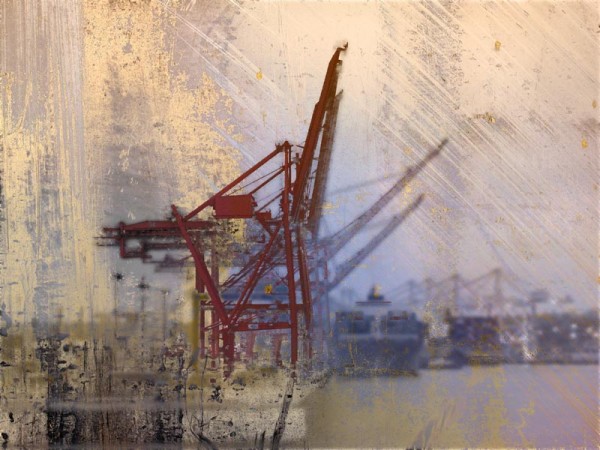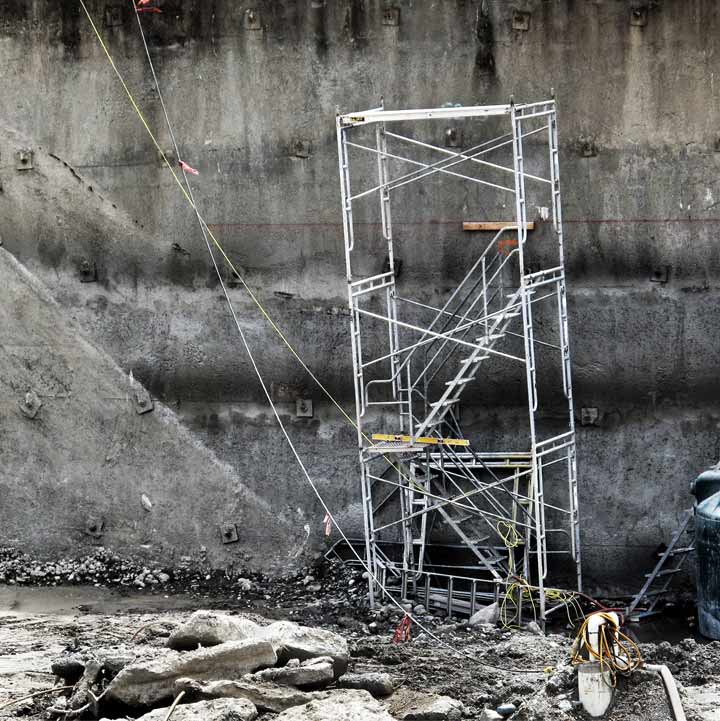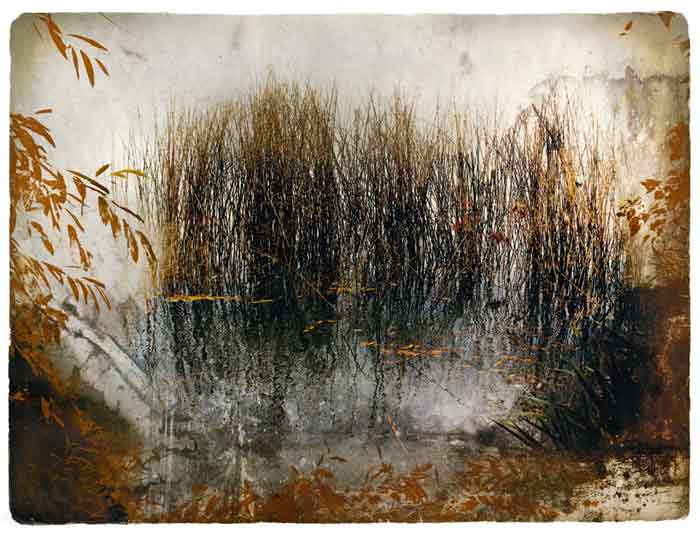
The Port, Morning, Digital Mixed Media Collage, 20″ x 27″
This piece from the new series in progress on Infrastructure is an appreciation of the cranes at Terminal 46 at the Port of Seattle. I took a photo with my phone in terrible lighting from the ferry as I was heading to Bainbridge Island. The very terribleness turned out to be exactly what I was looking for when I started working, although it took awhile for me to figure that out. I was drawn first to the collision of atmosphere and industry, and the elegiac sense of voyage and retrospect that the view from the ferry inspires. Then I fought for several weeks as I visited and revisited the image — fought with the very ‘industrialness’ that I loved in the first glimpse — exactly how bright do you want the floodlights to be anyway?? Aren’t those lights just basically ugly compared to the Rosy Dawn and the Dusky Gloaming? Along the way I have been learning a lot about what I’m actually looking at. (For instance, here you will learn everything you’ve ever wondered about the Terminal 46 lighting retrofit, and “foot candles” and pick up the term “light trespass.”) Embedded in this image are the textures of place collected from the Terminal and its surroundings.
The terminals are a place at the heart of recent controversies. The Port has pushed back on a proposal for a new third stadium in SODO, questioning the effect of yet another sports arena on the ability of the Port to get its trucks and trains through traffic. Simultaneously, coal trains could be coming soon if the coal port is approved at Cherry Point, with as many as 18 additional trains a day passing through the waterfront area and adding an estimated 90 minutes of traffic delays to an already congested area. If you would like to participate in what is sure to be a rousing civic event you may want to attend the panel discussion on the coal train proposal coming up at Town Hall on February 13th.
It is easy, if you are not a longshoreman or employed at the Port, to take the waterfront and a humming industrial infrastructure for granted. But as I did more research on Seattle’s maritime industry I came across remarkable stories and archival photographs documenting a history of upheaval. The site where crane number 54 sits once hosted Seattle’s own Hooverville. Between 1931 and 1941 over a thousand men called this home, living in a state of what a sociology student of the time termed “insane disorder.” This fascinating site documenting the Great Depression in Seattle tells the story. I stumbled across a fabulous image bank when I entered “Skinner and Eddy Shipyard 1918” in google. The link is too long to accurately place, but if you go to the image search you will find a trove of historical photographs of the waterfront, several of which have the epic quality of the opening scene of “Les Miserables.” The Port of Seattle website shows fascinating glimpses of the brutal labor history of our state with a portrait of Terminal 91 and The Battle of Smith Cove. WTO was just one in a long history of eruptions and disruptions. In spite of the Northwest’s stupefying natural beauty the people don’t seem to be pacified by it, and they don’t take social and economic change lying down.
Art that is about sense of place is inevitably also about history. If you capture place you enter a field of echoes. The thousands of accumulated abrasions, erasures, collisions, decisions, accidents and intentions, the changing weather of time’s passage, is embedded in everything you see. This is close cousin to “patina,” and you can find the loveliness of surface imperfection mass manufactured at Pottery Barn or the aptly named Pier 1. But it is also real, and it is everywhere around us in what is useful and working and necessary. It is a door into time.

This morning I delivered a set of new large prints to the Seattle Art Museum Gallery, including “The Port” above. The framed prints range from 32 x 40 to slightly smaller, and will be up at the gallery in the next few days. In printing larger pieces it has been a wonderful experience to work with The Color Group. The ink on the new Canon 9400 has really breath-taking vibrance, and particularly on Hahnemuhle German Etching this printer takes the medium beyond what I’ve seen before, with a unique blending of surface qualities similar to silkscreen or traditional lithography. I hope you will stop in to see the work in person. *Update: the work seems to be flying out the door, so go soon! These are editions of 20 so if a piece is gone that you like you can contact me about additional prints. The Pale Cranes might be my favorite, and it went out before it even got up on the wall.





